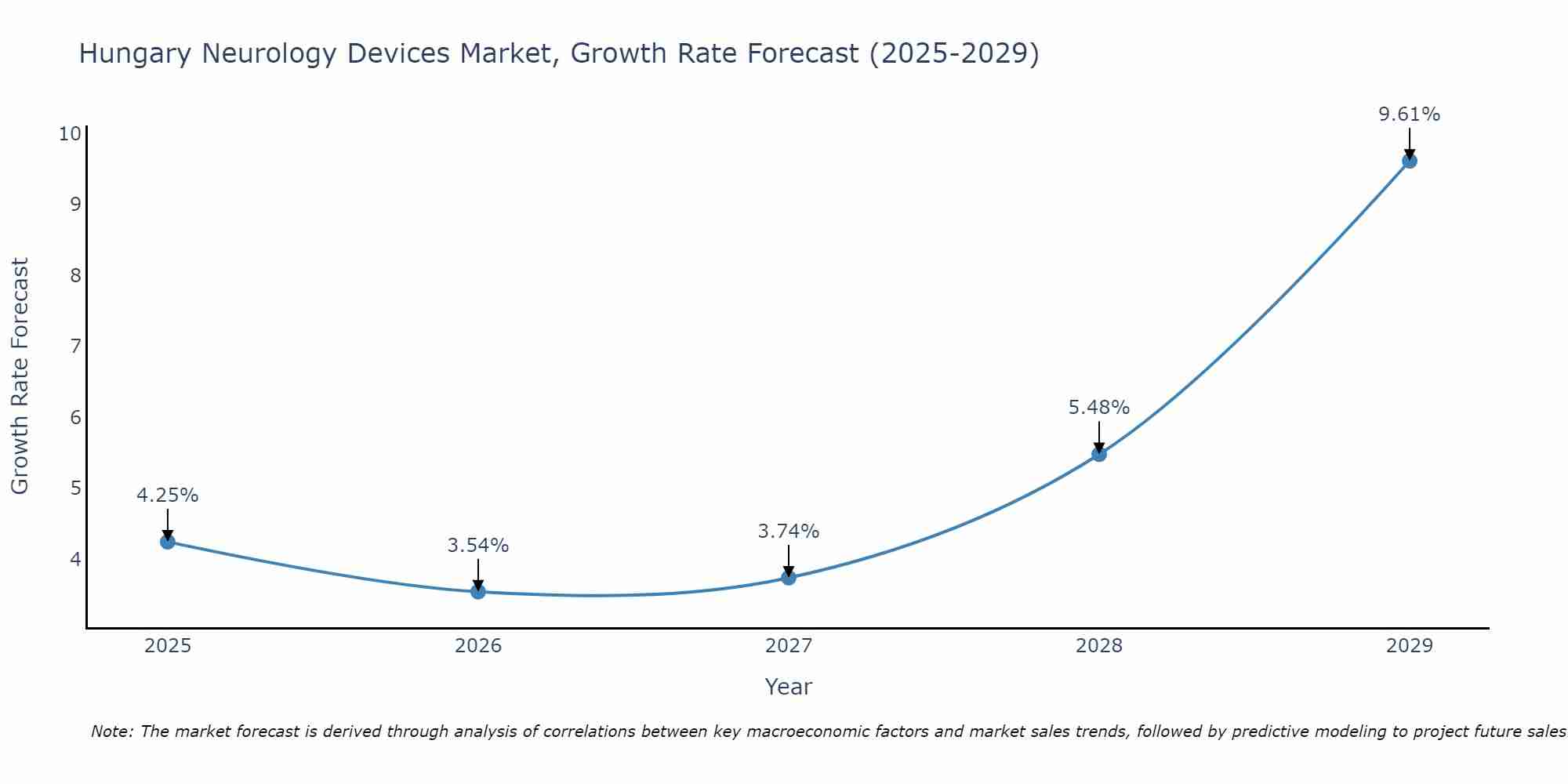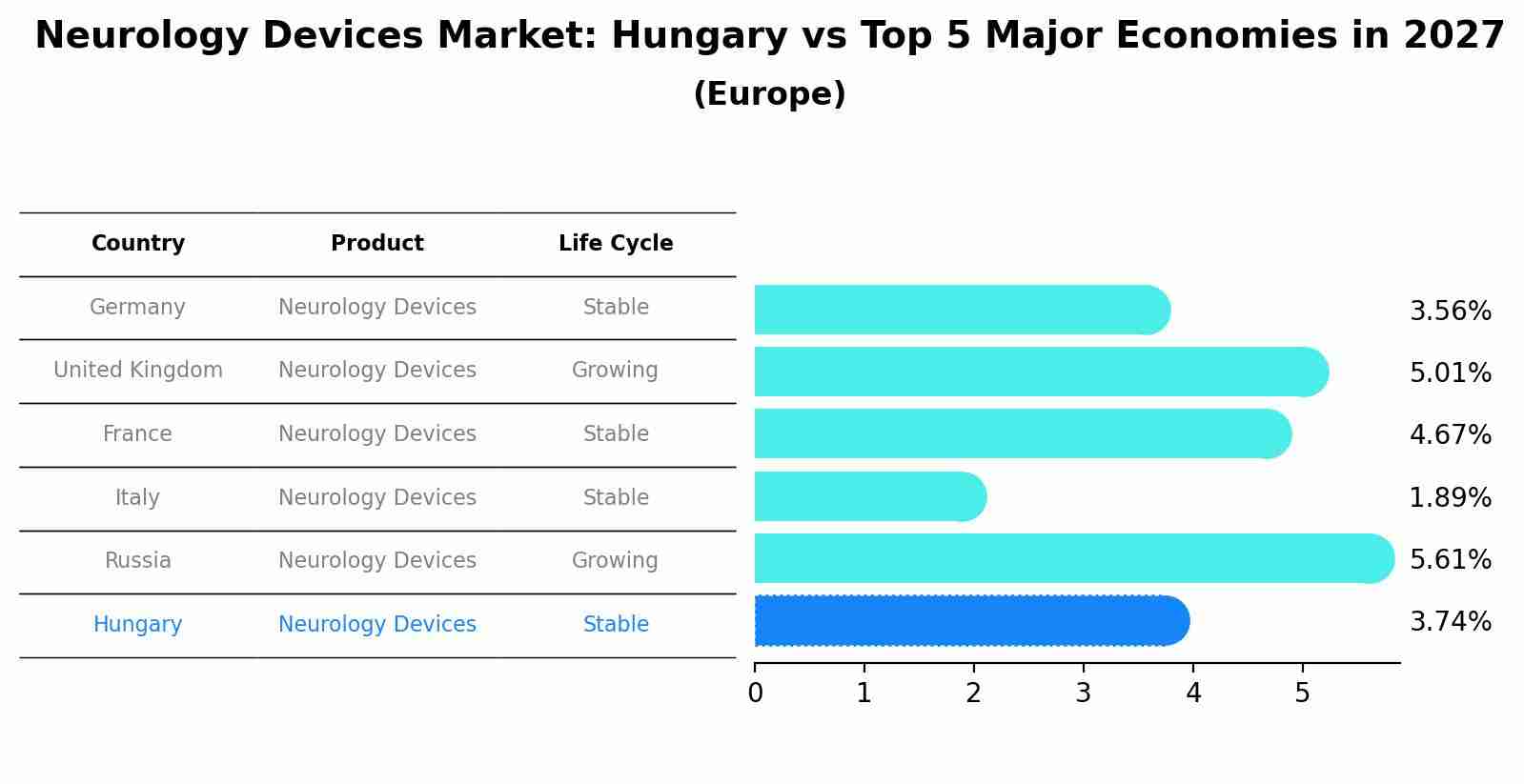Hungary Neurology Devices Market Outlook | Growth, Size, COVID-19 IMPACT, Forecast, Value, Share, Analysis, Revenue, Industry, Companies & Trends
| Product Code: ETC367639 | Publication Date: Aug 2022 | Updated Date: Apr 2025 | Product Type: Market Research Report | |
| Publisher: 6Wresearch | Author: Ravi Bhandari | No. of Pages: 75 | No. of Figures: 35 | No. of Tables: 20 |
Hungary Neurology Devices Market Size Growth Rate
The Hungary Neurology Devices Market is projected to witness mixed growth rate patterns during 2025 to 2029. Commencing at 4.25% in 2025, growth builds up to 9.61% by 2029.

Neurology Devices Market: Hungary vs Top 5 Major Economies in 2027 (Europe)
In the Europe region, the Neurology Devices market in Hungary is projected to expand at a stable growth rate of 3.74% by 2027. The largest economy is Germany, followed by United Kingdom, France, Italy and Russia.

Hungary Neurology Devices Market Overview
The Hungary neurology devices market is experiencing steady growth driven by factors such as the rising prevalence of neurological disorders, increasing healthcare expenditure, and technological advancements in medical devices. Key neurology devices include EEG machines, neurostimulation devices, and neurosurgical instruments. With a growing aging population and the expanding scope of neurological treatments, the demand for neurology devices is expected to remain robust in Hungary.
Drivers of the market
The increasing prevalence of neurological disorders and the growing aging population are key drivers for the neurology devices market in Hungary. As the incidence of conditions like Alzheimer`s disease, Parkinson`s disease, and epilepsy continues to rise, there is a corresponding surge in demand for neurology devices for diagnosis, treatment, and monitoring. Technological advancements in neuroimaging, neuromodulation, and neurosurgical devices are also contributing to market growth, enabling more precise and minimally invasive procedures.
Challenges of the market
The neurology devices market in Hungary encounters challenges related to high costs associated with advanced medical equipment and devices. Additionally, there is a need for continuous innovation to address complex neurological disorders effectively. Regulatory hurdles and reimbursement issues further impede market growth.
Government Policy of the market
The Hungary government recognizes the significance of neurology devices in improving healthcare outcomes and addressing neurological disorders. To support the development and adoption of such devices, the government has implemented policies aimed at streamlining regulatory processes and promoting research collaborations between academia, industry, and healthcare institutions. Furthermore, initiatives to enhance medical device manufacturing capabilities and ensure product quality standards are in place to foster a competitive market environment. The government also prioritizes healthcare infrastructure development to facilitate the efficient delivery of neurology services nationwide.
Key Highlights of the Report:
- Hungary Neurology Devices Market Outlook
- Market Size of Hungary Neurology Devices Market, 2021
- Forecast of Hungary Neurology Devices Market, 2028
- Historical Data and Forecast of Hungary Neurology Devices Revenues & Volume for the Period 2018 - 2028
- Hungary Neurology Devices Market Trend Evolution
- Hungary Neurology Devices Market Drivers and Challenges
- Hungary Neurology Devices Price Trends
- Hungary Neurology Devices Porter's Five Forces
- Hungary Neurology Devices Industry Life Cycle
- Historical Data and Forecast of Hungary Neurology Devices Market Revenues & Volume By Product for the Period 2018 - 2028
- Historical Data and Forecast of Hungary Neurology Devices Market Revenues & Volume By Neurostimulation Devices for the Period 2018 - 2028
- Historical Data and Forecast of Hungary Neurology Devices Market Revenues & Volume By Neurosurgery Devices for the Period 2018 - 2028
- Historical Data and Forecast of Hungary Neurology Devices Market Revenues & Volume By Interventional Neurology Devices for the Period 2018 - 2028
- Historical Data and Forecast of Hungary Neurology Devices Market Revenues & Volume By Cerebrospinal fluid management devices for the Period 2018 - 2028
- Historical Data and Forecast of Hungary Neurology Devices Market Revenues & Volume By Others for the Period 2018 - 2028
- Historical Data and Forecast of Hungary Neurology Devices Market Revenues & Volume By End User for the Period 2018 - 2028
- Historical Data and Forecast of Hungary Neurology Devices Market Revenues & Volume By Hospitals for the Period 2018 - 2028
- Historical Data and Forecast of Hungary Neurology Devices Market Revenues & Volume By Ambulatory surgery centers for the Period 2018 - 2028
- Historical Data and Forecast of Hungary Neurology Devices Market Revenues & Volume By Neurology clinics for the Period 2018 - 2028
- Hungary Neurology Devices Import Export Trade Statistics
- Market Opportunity Assessment By Product
- Market Opportunity Assessment By End User
- Hungary Neurology Devices Top Companies Market Share
- Hungary Neurology Devices Competitive Benchmarking By Technical and Operational Parameters
- Hungary Neurology Devices Company Profiles
- Hungary Neurology Devices Key Strategic Recommendations
Frequently Asked Questions About the Market Study (FAQs):
- Single User License$ 1,995
- Department License$ 2,400
- Site License$ 3,120
- Global License$ 3,795
Search
Thought Leadership and Analyst Meet
Our Clients
Related Reports
- Afghanistan Apparel Market (2026-2032) | Growth, Outlook, Industry, Segmentation, Forecast, Size, Companies, Trends, Value, Share, Analysis & Revenue
- Canada Oil and Gas Market (2026-2032) | Share, Segmentation, Value, Industry, Trends, Forecast, Analysis, Size & Revenue, Growth, Competitive Landscape, Outlook, Companies
- Germany Breakfast Food Market (2026-2032) | Industry, Share, Growth, Size, Companies, Value, Analysis, Revenue, Trends, Forecast & Outlook
- Australia Briquette Market (2025-2031) | Growth, Size, Revenue, Forecast, Analysis, Trends, Value, Share, Industry & Companies
- Vietnam System Integrator Market (2025-2031) | Size, Companies, Analysis, Industry, Value, Forecast, Growth, Trends, Revenue & Share
- ASEAN and Thailand Brain Health Supplements Market (2025-2031) | Strategy, Consumer Insights, Analysis, Investment Trends, Opportunities, Growth, Size, Share, Industry, Revenue, Segments, Value, Segmentation, Supply, Forecast, Restraints, Outlook, Competition, Drivers, Trends, Demand, Pricing Analysis, Competitive, Strategic Insights, Companies, Challenges
- ASEAN Bearings Market (2025-2031) | Strategy, Consumer Insights, Analysis, Investment Trends, Opportunities, Growth, Size, Share, Industry, Revenue, Segments, Value, Segmentation, Supply, Forecast, Restraints, Outlook, Competition, Drivers, Trends, Demand, Pricing Analysis, Competitive, Strategic Insights, Companies, Challenges
- Europe Flooring Market (2025-2031) | Outlook, Share, Industry, Trends, Forecast, Companies, Revenue, Size, Analysis, Growth & Value
- Saudi Arabia Manlift Market (2025-2031) | Outlook, Size, Growth, Trends, Companies, Industry, Revenue, Value, Share, Forecast & Analysis
- Uganda Excavator, Crane, and Wheel Loaders Market (2025-2031) | Strategy, Consumer Insights, Analysis, Investment Trends, Opportunities, Growth, Size, Share, Industry, Revenue, Segments, Value, Segmentation, Supply, Forecast, Restraints, Outlook, Competition, Drivers, Trends, Demand, Pricing Analysis, Competitive, Strategic Insights, Companies, Challenges
Industry Events and Analyst Meet
Whitepaper
- Middle East & Africa Commercial Security Market Click here to view more.
- Middle East & Africa Fire Safety Systems & Equipment Market Click here to view more.
- GCC Drone Market Click here to view more.
- Middle East Lighting Fixture Market Click here to view more.
- GCC Physical & Perimeter Security Market Click here to view more.
6WResearch In News
- Doha a strategic location for EV manufacturing hub: IPA Qatar
- Demand for luxury TVs surging in the GCC, says Samsung
- Empowering Growth: The Thriving Journey of Bangladesh’s Cable Industry
- Demand for luxury TVs surging in the GCC, says Samsung
- Video call with a traditional healer? Once unthinkable, it’s now common in South Africa
- Intelligent Buildings To Smooth GCC’s Path To Net Zero


















